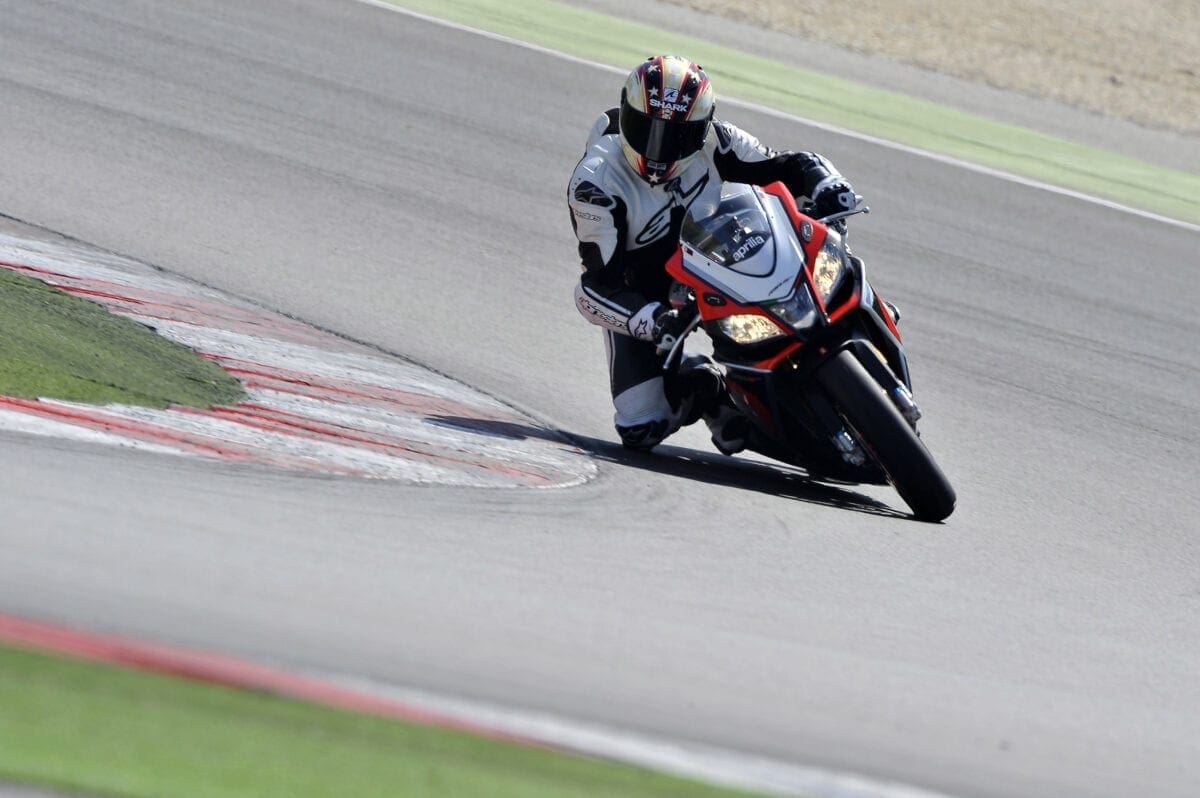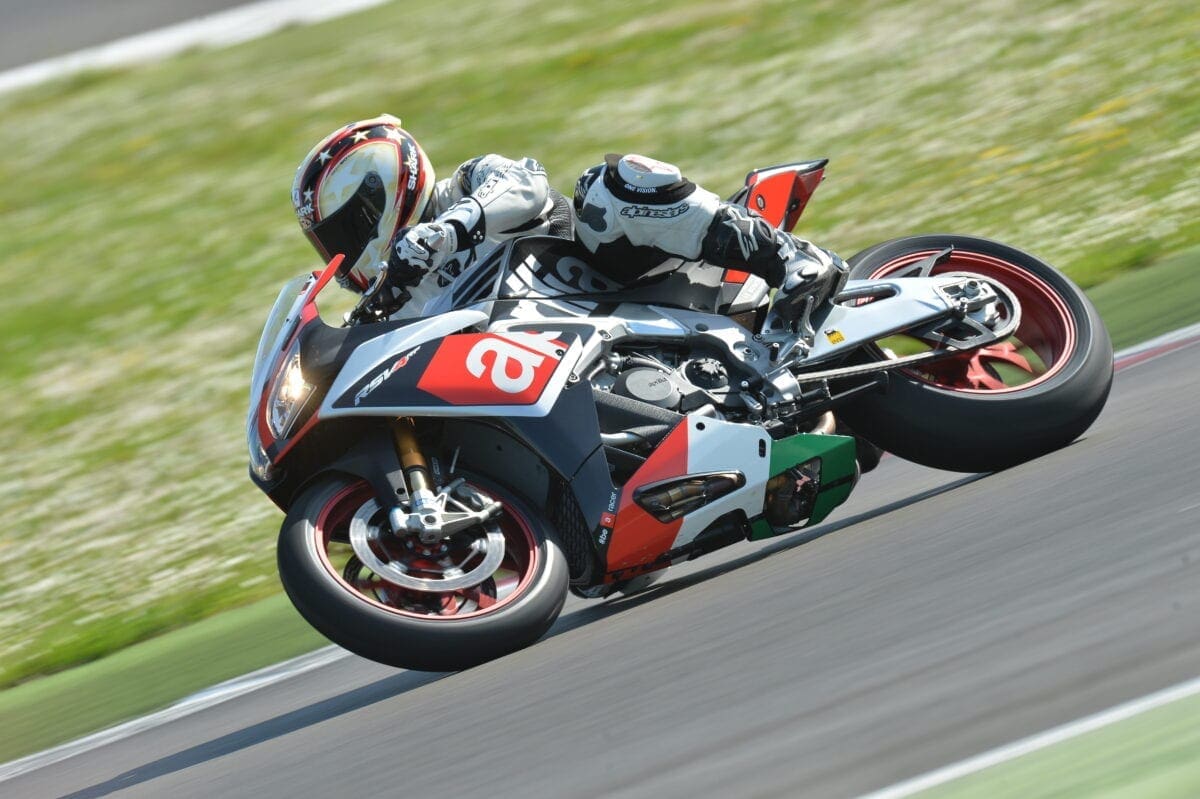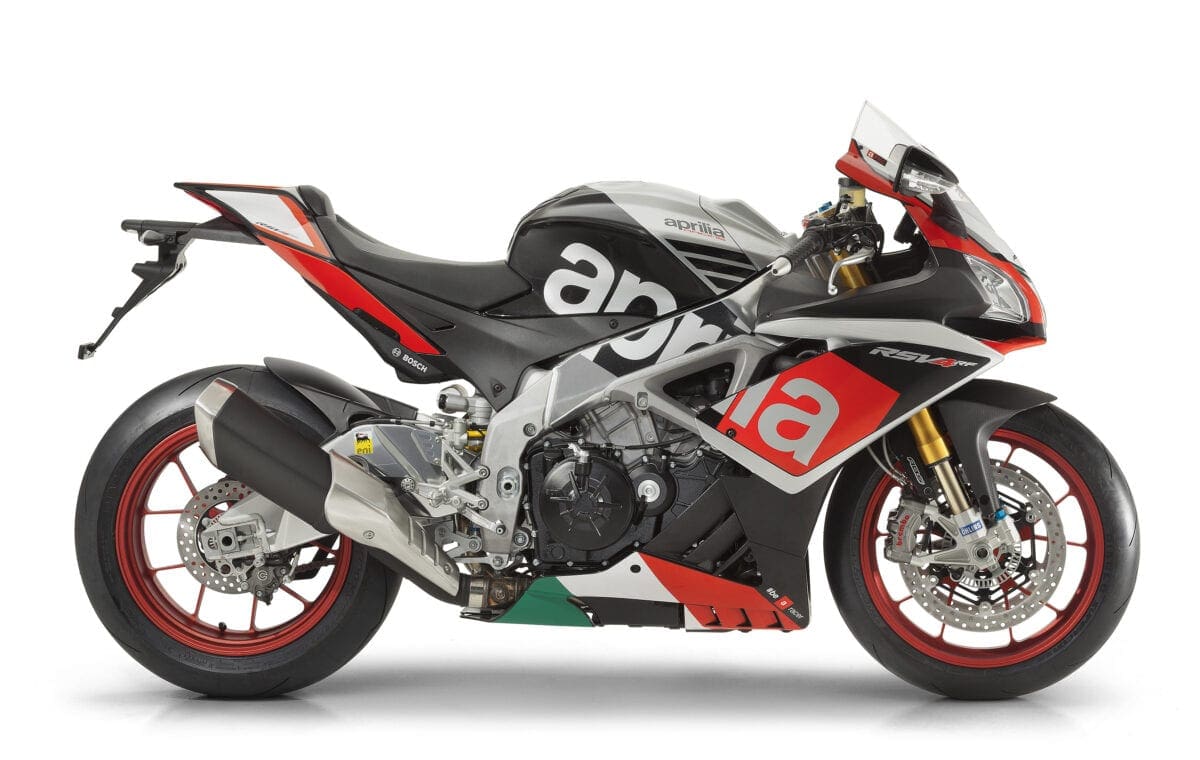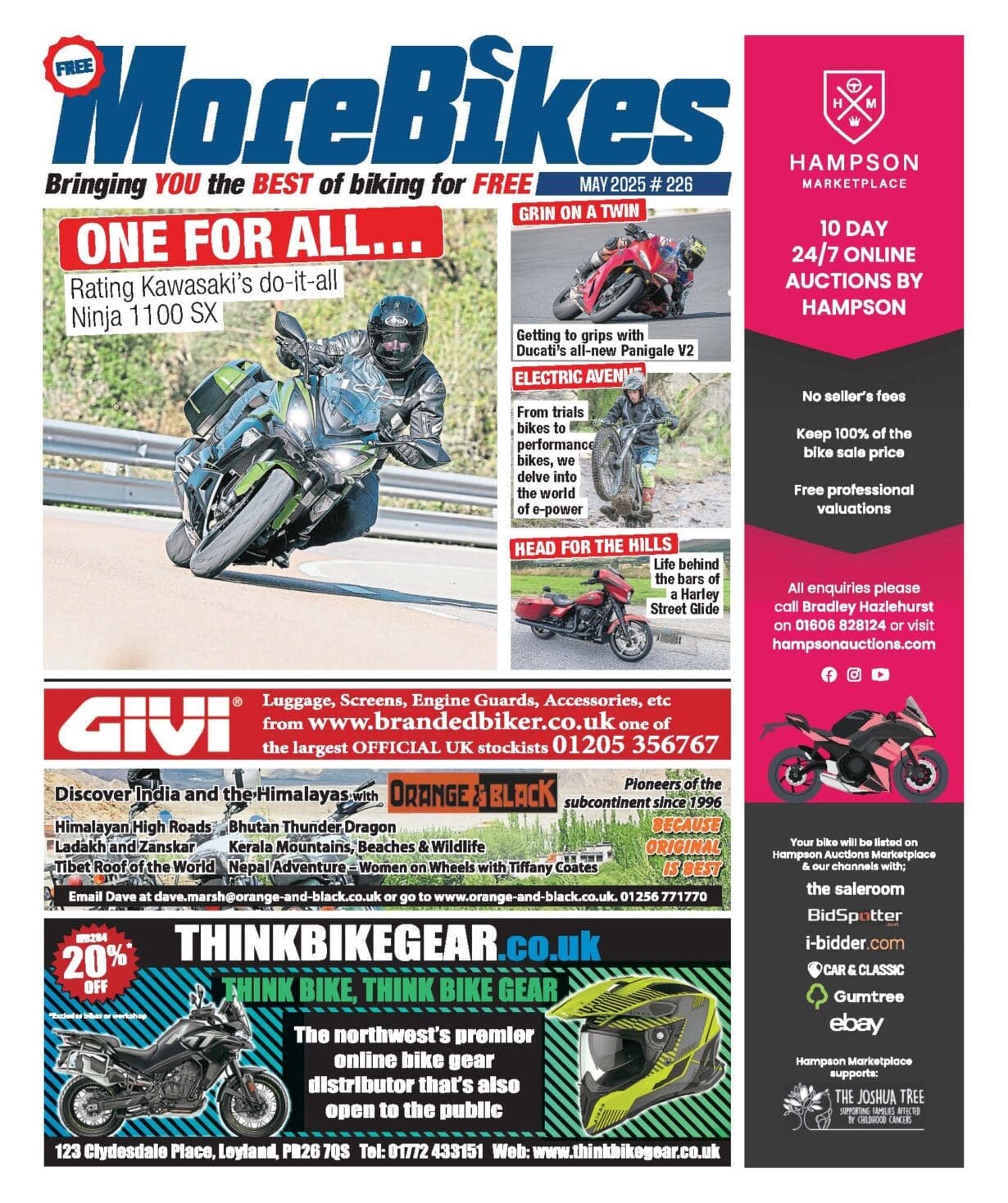£18,135//201bhp @ 13,000rpm//85ib-ft @ 10,500rpm//999.6cc 65 degree V-4 four-stroke, liquid cooled with DOHC
Tested by: Tony Carter Photography: Aprilia

This is the next generation of large Aprilia superbikes and, according to the factory itself, it’s the closest motorcycle they’ve ever made to what you see racing in World Superbikes every other Sunday of summer.
And right from the off during the world launch at the Misano circuit in Italy, the quality and ‘things-borrowed-from-race-teams’ is clear. The throttle pick-up, from 2000 to 14,000rpm, is instantly amazing. There’s not an engine underneath you but a supersmooth turbine of pure power. Flicking the bike through a few corners it’s clear that you’re riding something crafted by those who know about suspension.
Pick a line and the RSV barks obligingly and hurries along it. The brakes are WSB stoppers on the new front end and hit them hard enough to get the bike just lifting the back wheel and the new chassis (longer, lower centre of gravity, much more stable) isn’t phased.
In short, the first two laps of a circuit tell you everything you needed to know about this bike – the three elements of the modern superbike – are sorted and better than you could have hoped for.
The engine, all-new with a host of race-bits as standard is in the 200bhp club, 16bhp up on the old engine and is an absolute gem to use.
The chassis is all-new with a lower centre of gravity, a longer feel and pulled-in steering angle. It’s super clam and wonderfully easy to flick about.
The riding position is roomy, involved and whilst you’re not slotted ‘into’ the bike, you’re not perched on top of it. It’s almost the perfect compromise no matter who you are. Looks small but feels much bigger.
Tell me about the engine
That motor is luscious to use and has been vastly improved with more efficient machining and more clever electronics. Deliberately going into slow corners a gear too high doesn’t worry it, the electronics save your momentum and the engine note drops but it can stand hamfisted abuse. The power builds rapidly as you stir the pot and it’s so responsive (and gives a great ‘boost’ from about 8000rpm onward) that there’s a real delight in letting the bike rev and holding a gear between corners.

What’s the chassis like?
That chassis with the Sachs rear shock is predictable and tiny in feel. Where a month ago I was dragging the whole of the side of my boot on the floor on the Yamaha R1, on the RSV my toes never touched the track. That gives you some idea of just how narrow this bike feels. It never dominates the rider, mostly because it’s physically as intimidating as a nice pair of slippers.
The riding position puts you at less of a radical pitch to the bars than on the Tuono sibling. The bars feel wide at first but make sense on the move and that fairing is both easy to get under and absolutely brilliant at keeping the wind off.
How are the electronics?
Playing around with sub-routines in the digital brain isn’t straightforward however. It’s definitely worth investing time with the RSV4 and learning how to set up the myriad of options that you can dial in for traction control, throttle and anti-wheelie settings. I dropped the traction control over the course of a 20 minute session and from 7 to 4 there wasn’t too much difference in terms of feel, but 3 found the bike sliding just on the edge of my skillset. It’s a very sophisticated system in truth and knows your lean angle, throttle aggression and acceleration rates as you ride. You never feel the system butting in to the ride though, it’s seamless in its interaction and never detracts from sheer and repeated joy of cracking the throttle and listening to that V4 howl.
Turn eight at Misano is crucial because, like many turns at the track, of the straight that follows it. You jet along the track, lean into turn nine – but use it as part of the straight – and then fixate on braking for turn ten. I found that going into turn eight in second was fine but eventually I opted to hit turn eight in first, just so I could keep the revs high and enjoy a small slide on the exit. This happened after one session on the RSV and tells you just how at home with the RSV a new rider feels almost straight away.
Aprilia was at pains to ram home the message during the launch that this bike was built to echo the first RSV4 in 2009: the best, uncompromising superbike and one that comes closest to the real racing bike.
Without riding Haslam’s factory RSV4 it’s hard to say how close to that goal they’ve come with this bike, but what is immediately obvious is that here is a massive step forward for superbikes once again.
The RSV4 is an immense motorcycle. But at £3,000+ more than the Yamaha R1 it might find that it’s roundly beaten in the sales stakes. The track however, is a wildly different matter.
Specification – Arpilia RSV4-RF £18,135.00
[in brackets the data referring to RSV4 RF and RSV4 RR with Race Pack]
Engine type Aprilia longitudinal 65° V-4 cylinder, 4-stroke, liquid cooling system, double overhead camshafts (DOHC), four valves per cylinder
Fuel Unleaded petrol
Bore and stroke 78 x 52.3mm
Total engine capacity 999.6 cc
Compression ratio 13.6:1
Maximum power at crankshaft 201bhp (148 kW) at 13,000rpm
Maximum torque at crankshaft 85lb-ft at 10,500 rpm
Fuel system Airbox with front dynamic air intakes. Variable length intake ducts controlled via the engine control unit. 4 Marelli 48-mm throttle bodies with 8 injectors and latest generation Ride-By-Wire engine management.
Multiple engine maps selectable by the rider with bike in motion: T (Track), S (Sport), R (Race)
Ignition Magneti Marelli digital electronic ignition system integrated in engine control system, with one spark plug per cylinder and “stick-coil” type coils
Starter Electric
Exhaust 4 into 2 into 1 layout, two oxygen sensors, lateral single silencer with ECU-controlled bypass valve and integrated trivalent catalytic converter (Euro 3)
Alternator Flywheel mounted 450W alternator with rare earth magnets
Lubrication Wet sump lubrication system with oil radiator and two oil pumps (lubrication and cooling)
Transmission 6-speed cassette type gearbox
Gear lever with Aprilia Quick Shift electronic system (AQS)
Clutch Multi plate wet clutch with mechanical slipper system
Traction management APRC System (Aprilia Performance Ride Control), which includes Traction Control (ATC), Wheelie Control (AWC), Launch Control (ALC), all of which can be configured and deactivated independently.
Chassis Aluminium dual beam chassis with pressed and cast sheet elements.
Adjustments foreseen:
• headstock position and rake
• engine height
• swingarm pin height
Non adjustable Sachs steering damper
[Adjustable Öhlins steering damper]
Front suspension Sachs Fork with 43mm stanchions; [Öhlins fork with TIN surface treatment]. Low profile forged aluminium radial calliper mountings. Adjustable spring preload and hydraulic compression and rebound damping. Wheel travel: 120 mm
Rear suspension Double braced aluminium swingarm; mixed low thickness and sheet casting technology.
Sachs monoshock adjustable in: hydraulics in rebound damping and compression, spring preload, centre-to-centre length [Öhlins Racing monoshock with piggy-back, fully adjustable in: spring preload, wheelbase and hydraulic compression and rebound damping. APS progressive linkage. Wheel travel 130 mm.
Brakes Front: Dual 320-mm diameter floating stainless steel disc with lightweight stainless steel rotor and aluminium flange with 6 pins. Brembo M430 monobloc radial callipers with 4 x 30mm pistons. Sintered pads. Radial pump and metal braided brake hose
Rear: 220 mm diameter disc; Brembo calliper with two x 32 mm separate pistons. Sintered pads. Pump with integrated tank and metal braided hose
ABS Bosch 9MP, adjustable to 3 maps, equipped with RLM (Rear wheel Lift-up Mitigation) strategy which can be disengaged
Wheel rims Aprilia aluminium alloy rims with 3 split spokes, [forged aluminium alloy, completely machined, 5 split spokes].
Front: 3.5”X17”
Rear: 6”X17”
Tyres Radial tubeless.
Front: 120/70 ZR 17
Rear: 200/55 ZR 17 (alternative: 190/50 ZR 17; 190/55 ZR 17)
Dry weight 180 kg*
Tank 18.5 litres (4-litre reserve included)
*Kerb weight, without battery and fluids.





